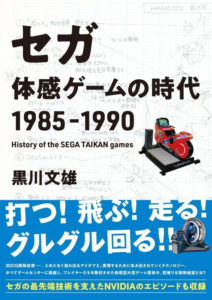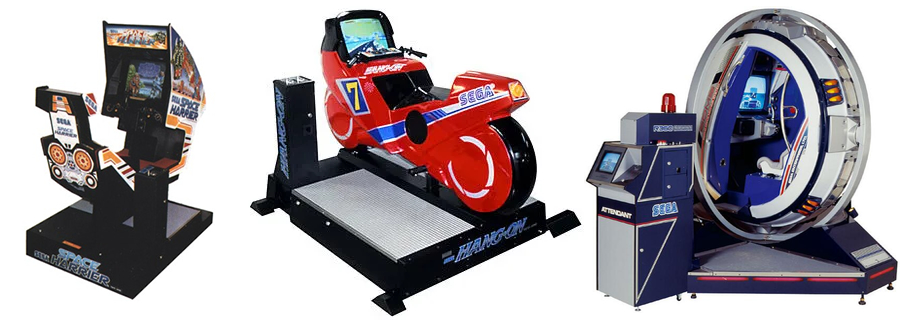I love books about Sega history (I’ve written three!), especially those from Japan. A lot of gaming history from that side of the pond remains unknown, so it’s wonderful to see local Japanese historians document the events and people that made so much of our gaming so much fun. A lot of it stays in Japan, and the language barrier proves too much for most people. However. thanks to machine translation, these books can now be enjoyed by those who don’t speak Japanese. The translations aren’t perfect, but they’re good enough to get an understanding of what’s being discussed and can create a great starting point for research.
 Imagine my joy then, at the news that Tokyo News Tsushinsha will release a new book this May that chronicles the history of Sega’s pioneering motion-simulation arcade games produced between 1985 and 1990. The 284-page book will be priced at 2,200 yen (around $16). This release promises a thorough examination of the era during which Sega pushed the limits of arcade entertainment like no other company, using frontier technology and interactive cabinet design.
Imagine my joy then, at the news that Tokyo News Tsushinsha will release a new book this May that chronicles the history of Sega’s pioneering motion-simulation arcade games produced between 1985 and 1990. The 284-page book will be priced at 2,200 yen (around $16). This release promises a thorough examination of the era during which Sega pushed the limits of arcade entertainment like no other company, using frontier technology and interactive cabinet design.
The work, titled: Sega: The Era of Sensory Games 1985-1990, is written by Fumio Kurokawa, a seasoned games journalist and former Sega AM2 section manager. Kurokawa has been engaged in research and documentation of digital media for years and has published several game-related works, including interviews with gaming alumni and the book SHis hands-on experience at various game companies like Sega and Konami has provided him with a balanced knowledge of both the business and creative sides of game creation. Additionally, he regularly writes for 4Gamer, where he has a series of features covering prominent voices within the world of video games.
The book is an in-depth look at the technical and artistic labor that went into making some of Sega’s most iconic motion-based arcade games. It includes interviews with a number of the most influential game designers and engineers responsible for making Sega’s classic titles during this golden era. Among those interviewed are legends like Yu Suzuki, the conceptual mind behind most of Sega’s largest projects; Hisao Oguchi, a significant figure in Sega’s arcade division; Hideki Sato, one of its best hardware designers; and Hiroshi Kawaguchi, who created legendary music for several arcade classics like Space Harrier.
A ton of games are covered in the book, such as Hang-On, the motorbike racing game that debuted Sega’s ride-on cabinet format and helped launch Sega of America; OutRun, the classic driving game renowned for its branching routes and atmospheric soundtrack, and After Burner, AM2’s frantic air combat simulator with a tilting and shifting cabinet. Even the R360, Sega’s monumental, gyroscopic arcade cabinet that spun 360 degrees, is included. All of these games created a novel sensory experience that was unmatched during the era, and it’s great to see them all discussed with those who made them.
Drawing on previously unseen internal reports, design memos, and firsthand accounts, The Era of Sensory Games constructs a detailed history of how Sega set about making these ambitious projects. It examines the technological innovations required to create physically interactive arcade cabinets, the design philosophies regarding game mechanics and user experience, and the collaboration between engineers, designers, and composers. From Kurokawa’s insider perspective, readers will witness the fascinating problem-solving and experimentation that made Sega a success as a leader in the arcade industry and a gaming icon. I haven’t seen the inside yet, but from Kurokawa’s description, I’d wager there has to be a good selection of images, as well. He has often shared his experiences accessing cool spots (like the warehouse housing many of Sega’s classic arcade machines!)
Finally, the book looks back at the history of these simulation games, showing how their spectacle and size drew players in and helped them reach the pinnacle of popularity in arcades around the world. It also discusses how these games eventually declined as consumer interest and market conditions changed. With this constrained historical perspective, the book could serve as both an homage to Sega’s technical and artistic achievements as well as a chronicle of a pivotal moment in the evolution of interactive entertainment. With 284 pages, The Sensory Era has a lot of potential to cover a lot of ground in Sega’s arcade history.
I’ve already pre-ordered my copy on Amazon Japan, and you can do so here. We’ll have a full review of the book as soon as it arrives, and we can’t wait to see what new info it brings to the Sega discourse.


Recent Comments